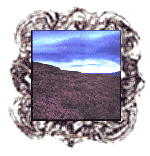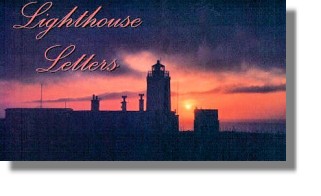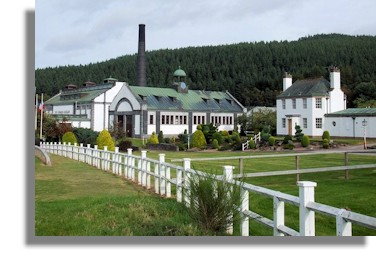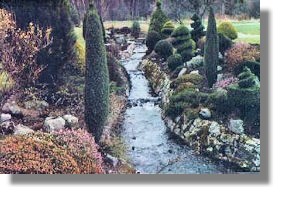

Lighthouse Letters
By Sharma Krauskopf
This is an article by Sharma Krauskopf from Michigan who fell in love with Scotland - and decided to buy a lighthouse keepers' cottage at Eshaness, a remote location in Shetland, in the far north of Scotland and live there each winter. These pages were previously part of the "Scottish Radiance e-magazine Web site which was created by Sharma.
The Distillery Gardener

View down the Spey valley to Ben Rinnes and Tormore distillery by Richard Webb, via Wikimedia.
Did you ever begin a task thinking one thing was going to happen and instead something totally different occurred? Often the outcomes are dreadful but once in a while they are fabulous. This happened during this year's January's trip to Scotland when I accompanied my husband on some interviews he was doing for "The Gardening Show", his weekly Detroit radio program. The assignment was to interview gardeners at distilleries in the Spey valley.
His first interviewee was Jim McBain at Tormore distillery near Granton-on-Spey (picture here is by Ronnie Leask via Wikimedia).Our friends the Macdonald's (See Lighthouse Letter "Goodbye to Orbost") had moved to Castle Grant Home Farm and so we were very near Tormore. Margaret Macdonald provided our transportation since we did not have a car. It had been three years since I had been in this part of Scotland so I was really looking forward to seeing the countryside. It was a perfect day to visit a garden with the sun shining on beautiful green hills framed with a dusting of frost on the bushes along the road. It was Scotland at its very best.
The Tormore Distillery sits on the side of a steep hill overlooking the lovely Spey valley. In the distance was a field with Highland cattle grazing on the edge of the River Spey . It is a lovely spot made even more so by the beautiful topiary garden which surrounds a burn tumbling merrily down the hill beside the distillery. While Dean went to meet Jim, Margaret and I wandered the grounds inspecting the heather and the fanciful creatures made out of bushes. The topiaries were in the shapes of birds, Scottish thistles, and cones just to name a few. Margaret and I had not expected to be a part of the tour but Jim McBain insisted we accompany him through the garden.
The garden follows the burn up the hillside. The higher we went the more peaceful and secluded it becomes. Civilization disappeared. Jim had all kinds of amazing things growing on the hillside and it was absolutely stunning. It became obvious the garden was so captivating because of the special care Jim put into it. I fell totally under the spell of Jim from the moment I met him. He was articulate, a great story teller and loved nature and Scotland. Every year when the pond which is used to catch the water for the distillery was drained and cleaned, Jim caught the brown trout which lived there and carried them up the mountain. He released them high in the hills so they could travel back to the pond when it was full again. He had one fish he knew by sight that he had moved for the last nine years. This was only one of the many stories he tells of his relationship with the creatures which lived in his gardens.
On our way back down the hill to the distillery he insisted we stop by the pond for a short rest. Like a magician taking a rabbit from a hat he produced a bottle of Tormore's single malt from the whisky safe along with a strange looking silver flask without a top on a long rope. He gracefully threw the flask into the pond filling it with the cool clear water. He added a drop of the water to a wee dram of whisky in each of our glasses. Margaret and I were not whisky drinkers but we both admitted later that was the best Scotch we had ever had. Jim was not a man of doing things half way. He pulled from his pocket shortbread to accompany our drink. "The best shortbread in Scotland," Jim informed us. I must admit it was wonderful. By now I felt like I had known Jim all my life and was hanging on his every word. He had so many stories to tell. The tales ranged from when his father was the gardener at Balmoral to how he let the bushes dictate to him what shape they wanted to become in the topiary garden.
When we reached the bottom of the garden, Jim invited us into the club house to see his some of his pictures. I do not know why it surprised me but among all of his other talents Jim was an exceptional photographer. Last month's column contained some of his capercaillie pictures and I have added a couple of pictures to this column. His pictures were spectacular and they covered all areas of Scotland. I felt like I was taking a tour of Scotland without leaving my chair. (Not the usual boring holiday pictures but spectacular photographs.)
Jim volunteered to come over to Castle Grant Farm the next night and bring the slides for me to take home. We had all fallen so completely under his spell we were delighted. We all wanted Robert, Margaret's husband, to meet him.
True to his word Jim appeared the next night. Instead of going through the slides before hand, we were treated to another slide show with accompanying stories (that's his picture on the right of the river Spey in the evening). I was allowed to pick the slides I wanted to take home as we went. (I used great discipline and selected ONLY 65 slides which cost me $87.00 to process! ) During the evening we discovered Jim also designed flower arrangements for weddings and made walking sticks.
I was amazed at what went into making a good walking stick. It is a complete art form and a topic for another column. In fact Jim McBain is a topic for a complete book and maybe when I finish the rewrite on Gealach Head, my novel, I will write one entitled the Distillery Gardener.
Return to Index of Lighthouse Letters or Index of All Guest Writers







